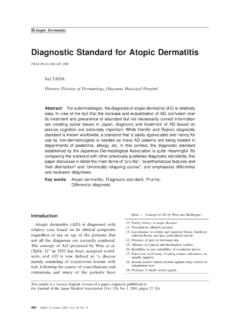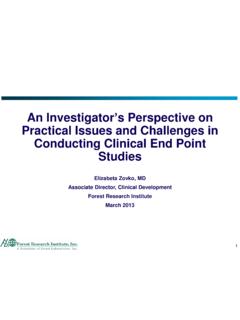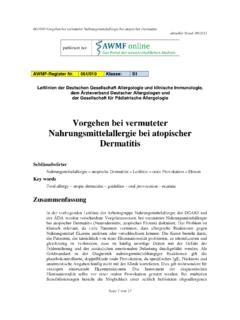Transcription of Emollient Prescribing Guideline for Primary and Secondary Care
1 Southwark Clinical Commissioning Group Lambeth Clinical Commissioning Group This document was developed by clinicians of NHS Lambeth CCG, NHS Southwark CCG, Departments of Dermatology and Pharmacy GSTFT & KCH. Please direct any queries to or Approved by: NHS Lambeth CCG and NHS Southwark CCG Joint Prescribing Committee Date: Sept 2013 Review date: Sept 2015 Page 1 of 4 Emollient Prescribing Guideline for Primary and Secondary Care This Guideline has been developed for use in the management of patients with a diagnosed dermatological condition or skin integrity is at risk through xerosis or pruritus. Its application must be guided by professional judgement.
2 Those people without a diagnosed dermatological condition requesting a general skin moisturiser may purchase these over the counter. The list of preferred products has been added to the Guys, Kings, Lewisham and St. Thomas s Joint Medicines Formulary. Consistency/ Formulation Preferred Products Active Constituents Advice, Restrictions and/or Similar product Cost per 500ml/g (LP = Liquid Paraffin, WSP = White Soft Paraffin, EW = Emulsifying Wax, WP = White Paraffin, LLP = Light Liquid Paraffin, YSP = Yellow Soft Paraffin) (Excipients listed are associated rarely with sensitisation as listed in BNF65/ MIMs online) (Drug Tariff + MIMs online; August 2013) Very Greasy ointment White soft paraffin in liquid paraffin (50:50) LP 50% + WSP 50% For very dry skin and/ or acute flares.
3 Low risk of sensitivity. Greasy ointment Emulsifying ointment WSP 50% + EW 30% + LP 20% Excipients: cetostearyl alcohol Good for night-time, very dry skin or scaly patches requiring softening. Zeroderm ointment LP 40% + WSP 30% + EW Excipients: cetearyl alcohol, polysorbate 60 Same as above SIMILAR TO: Epaderm Ointment Hydromol ointment YSP 30% + EW 30% + LP 40% Excipients: cetostearyl alcohol Same as above SIMILAR TO: Epaderm Ointment Creams / gels ZeroAQS LP 6% + WSP 15% + macrogol cetostearyl ether Excipients: cetostearyl alcohol, chlorocresol SIMILAR TO: Oilatum cream and Diprobase Cream Aquamax WSP 20% + LP 8% Excipients: cetostearyl alcohol, polysorbate 60, phenoxyethanol Zerocream LP +WSP , anhydrous lanolin 1% Excipients.
4 Cetyl alcohol, hydroxybenzoates (parabens) SIMILAR TO: E45 cream (note this contains hypoallergenic anhydrous lanolin) Doublebase gel Isopropyl Myristate 15% + LP 15% Excipients: triethanolamine, phenoxyethanol Cetraben cream WSP + LLP + EW Excipients: cetostearyl alcohol, phenoxyethanol, hydroxybenzoates (parabens) Lotion E45 lotion WSP 10% + LLP 4%, hypoallergenic anhydrous lanolin 1% Excipients: benzyl alcohol, isopropyl palmitate, hydroxybenzoates (parabens) Lighter formulation suitable for application to hairy areas, skin folds, face or scalp (ACBS: see BNF drug monograph) QV Skin lotion WSP 5% + LP Excipients: cetostearyl Alcohol, hydroxybenzoates (parabens) Same as above Southwark Clinical Commissioning Group Lambeth Clinical Commissioning Group This document was developed by clinicians of NHS Lambeth CCG, NHS Southwark CCG, Departments of Dermatology and Pharmacy GSTFT & KCH.
5 Please direct any queries to or Approved by: NHS Lambeth CCG and NHS Southwark CCG Joint Prescribing Committee Date: Sept 2013 Review date: Sept 2015 Page 2 of 4 Preparations containing anti-microbials Dermol 500 lotion LP + benzalkonium chloride + chlorhexidine dihydrochloride + isopropyl myristate Excipients: cetostearyl alcohol, phenoxyethanol Short term use to wash and/ or as a leave on Emollient during skin infection only Dermol cream LP 10% + benzalkonium chloride + chlorhexidine dihydrochloride + isopropyl myristate 10% Excipients: cetostearyl alcohol, phenoxyethanol Same as above Eczmol cream (lotion) Chlorhexidine gluconate solution 1%, LP + WSP Excipients: cetostearyl alcohol Same as above ( = 250ml) Soap substitute Use any cream or ointment above as a soap substitute in the bath/shower.
6 Except 50:50 (since it may not lather well) Preparations containing urea Balneum cream Urea 5% + ceramides Useful where a keratolytic is required hyperkeratosis, ichthyosis, extremely dry and/ or fissured skin on hands and feet Aquadrate cream/ Hydromol Intensive cream Urea 10% + WSP Same as above ( = 100g) Spray Emollient Emollin LP 50% + WSP 50% Excipients: cetostearyl alcohol, polysorbates, propylene glycol For very painful/ fragile skin where there is difficulty with hands on application of creams / ointments only ( = 240ml) FOR USE IN EXCEPTIONAL/SPECIFIED SITUATIONS ONLY Bath emollients/ Wash products Hydromol bath and shower Emollient LLP + isopropyl myristate 13% To wash dry scalps/ as soap substitutes where other emollients are unsuitable/ not tolerated Note: Risk of slipping in bath.
7 QV Bath oil LLP Excipients: hydroxybenzoates (parabens) Same as above Dermol 600 bath Emollient with antimicrobial LP 25% + benzalkonium chloride + isopropyl myristate 25% Excipients: polysorbate 60 Short term use during skin infection only Tissue viability - Leg ulcer wash only (600ml) Acknowledgements: Our thanks go to Dr Catherine Smith (Consultant Dermatologist GSTFT), Dr Emma Wedgeworth (Consultant Paediatric Dermatologist GSTFT), Dr Sarah Walsh (Consultant Dermatologist KCHFT), Karina Jackson (Consultant Nurse GSTFT), Arlene McGuire (Dermatology Pharmacist GSTFT), Charlotte Bell (Dermatology Pharmacist KCHFT), Dr Naomi Kemp (GPwSI Southwark), Dr Dianne Aitken (GP Lambeth) and Dr Elizabeth Williams (GP Lambeth) for giving their time & expert advice to produce this document.
8 References: Care Dermatology Society & British Association of Dermatologists guidelines for the management of atopic eczema, SKIN Vol 39 Oct 2009; 2. NICE Clinical Knowledge Summaries; #!prescribinginfosub:3 3. BNF 65 March Sept 2013; ; 4. NICE Clinical Guideline 57 Atopic eczema in children December 2007 ; 5. NHS Choices; ; 6. NHS National Patient Safety Agency Rapid Response Report 4 Fire hazard with paraffin based skin products on dressings and clothing November 2007; ; 7. British Dermatological Nursing Group Best Practice in Emollient Therapy A Statement for Healthcare Professionals; Dermatological Nursing, 2012, Vol 11, No 4; 8.
9 MHRA Drug Safety Update, Volume 6, issue 8, March 2013: Aqueous cream: may cause skin irritation, particularly in children with eczema, possibly due to sodium lauryl sulfate content; Southwark Clinical Commissioning Group Lambeth Clinical Commissioning Group This document was developed by clinicians of NHS Lambeth CCG, NHS Southwark CCG, Departments of Dermatology and Pharmacy GSTFT & KCH. Please direct any queries to or Approved by: NHS Lambeth CCG and NHS Southwark CCG Joint Prescribing Committee Date: Sept 2013 Review date: Sept 2015 Page 3 of 4 KEY INFORMATION FOR Emollient Prescribing : Assess patient to diagnose a dermatological condition such as eczema, psoriasis or symptomatic xerosis or pruritus caused by systemic disease that threatens skin integrity in older patients.
10 Emollients can be purchased over the counter by patients who do not have a diagnosed dermatological condition or risk to skin integrity. (For diagnostic criteria for atopic eczema refer to the guidelines for the management of atopic eczema1). All Primary and Secondary care prescribers should where possible select the Emollient with the lowest acquisition cost from the range available in our agreed preferred product list. Newly diagnosed patients: Offer the product with the lowest acquisition cost from the above preferred list appropriate to their condition. Existing patients with a diagnosed dermatological condition prescribed an Emollient outside the preferred product list: Review with a view to trialling a preferred Emollient from the list above.




